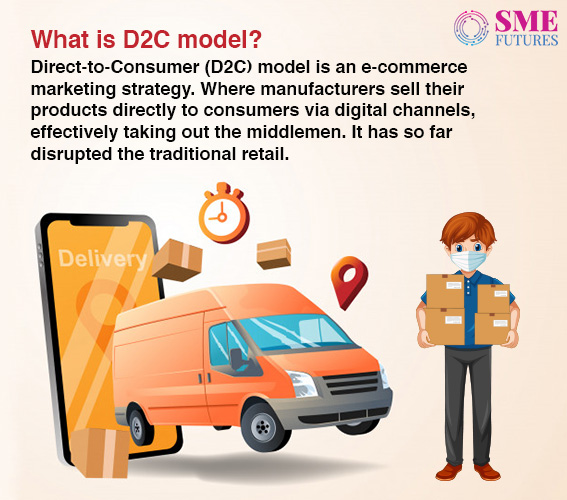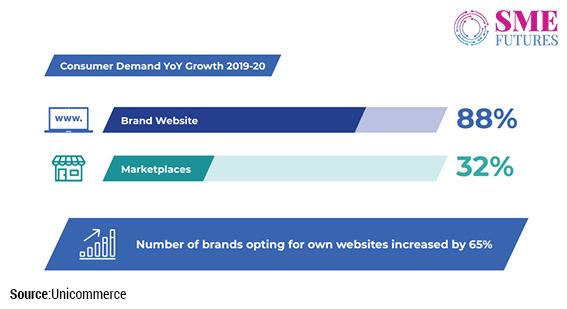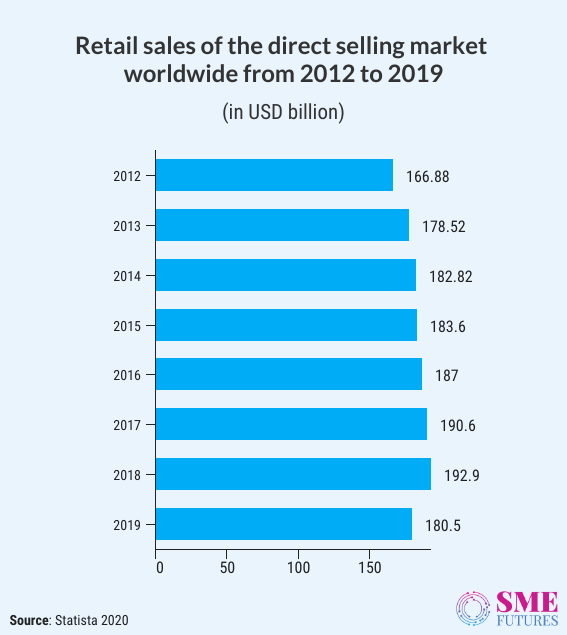With the fear of coronavirus still lingering, there is a paradigm shift in the buying pattern and shopping preferences of consumers. They have become habituated to online purchases which ensure their safety at homes. This has pushed the growth of e-commerce market to 17 per cent as compared to pre-lockdown order volume.
Even people from hinterlands are adjusting their behaviors and shopping online. This has further led to customer savvy direct-to-consumer (D2C) approach. While the businesses are adversely impacted during the pandemic, D2C businesses are proving to be resilient.
Further, the brands with dominating online presence also know that it is critical to pivot their strategies to support their customers’ experiences with shifting bends. Thus, even these platforms have adopted the D2C growth business strategy to survive.
Let’s first understand what it means to be a D2C brand. One simple explanation is that

In the past, going direct to the manufacturer was the only way retail was done. For instance, people who wanted to buy mustard oil went to buy it from oilmen in their vicinity. But as marketplaces evolved, a variety of products came and consumer-manufacturer relationship was replaced by consumer-retailer. Also, various channels dealing with manufacturer to retailers also emerged in between.
The retail landscape evolved with evolution of e-commerce and emergence of digital age. It also empowered small businesses and gave them the ability to compete with bigger brands. One such example of a D2C brand is, Dollar Shave Club. It was a small business until 2015. With its D2C approach it was able occupy huge market of 52.5 per cent from Gillette.
Brands actively adopting direct-to-customer
Earlier, the D2C model existed in India in sectors such as insurance. Over the time, various brands in fashion, lifestyle and personal care also adopted the model. Mamaearth, Beardo, Ustra are good examples of it. Hence, retail landscape has now become more hyper-connected while dealing with the crisis and with D2C trend gaining momentum.
According to a research by Unicommerce, an online retail focused tech platform, the number of consumers shopping directly from the website has witnessed a growth of 88 per cent as compared to 32 per cent growth on the marketplace.
Discussing about the rising trend of D2C in his blog, Kapil Makhija, CEO at Unicommerce says, “There is also emerging trends of neo-D2C models, which is widely followed by big brands with strong brand value and connect with consumers. These brands work towards building the right mix of selling on marketplace and brand websites.”
Watching the trend, bigger brands have also entered the bandwagon of taking the end-to end control of the product’s journey. This in turn is building a robust selling infrastructure for the product. Take the example of beverage giant PepsiCo. The brand has launched new D2C platforms to pre-empt future disruptions.
Another example is of FMCG brand Nivea, which has also adopted direct to consumer approach while partnering with Zomato and Swiggy in March. It is now delivering personal hygiene and skincare products across India.
Further, ITC started store on wheels, which parked in residential complexes and from where consumers shopped their requirements during the lockdown period. Some premium brands such as Lifestyle are also offering a feature where staff members will show clothes on video calls and later deliver it to customers.
Similarly, Bisleri initiated Bisleri@Doorstep initiative in April. Through this, consumers can directly order on their websites or by calling customer care number. As per a company official, the company’s aim through D2C model is to address any demand and supply gaps in the market. On the same note, Dabur also launched its doorstep services for meeting the demand of medicines.
The latest addition in this trend is electronics major LG. It has launched direct-to-consumer online store. LG would use its network of existing local warehouses from where it would deliver orders using third-party partner vendor. According to Deepak Taneja, LG India Online Business Head, this online store would be a complementary to LG’s overall channel.
Deepak claims in a statement, “Across the entire e-commerce ecosystem, we have noticed a surge in consumer demand for home appliance and electronics post lockdown. During the pandemic period, consumers prefer to be at home. Hence, we are expecting a fast-moving growth in both home appliance and home entertainment products.”
Director-to-customer popular among all
As e-commerce has matured, businesses have a great chance to harness opportunities from these platforms. Offline stores are now deserted due to the coronavirus, more and more brands are building their own online portfolio. Medium and small businesses have also understood the significance of this new trend.
Top three segments that have witnessed increasing penetration of D2C brands are beauty and wellness; fashion and accessories; and FMCG and agriculture products. In current scenario, many companies have converted them into a D2C brand, while others are planning to start their online selling channels soon.
Talking about embracing the D2C ecosystem, homegrown FMCG premium tea brand Samaara Tea has recently launched its digital campaign focusing on a D2C sales medium. According to its CEO Dheer Shah, the time is of digital first businesses. With the pandemic’s worst hit on retail, the footfall of people in stores is significantly diminishing.
“In such a situation Samaara Tea, which offers the strongest everyday tea, is also looking at digital mediums for growing D2C commerce. There is a lot of potential in exploring D2C business and it is expected to grow in the coming months,” he adds. Currently, the presence of tea brand is in Middle East, South Africa, USA, UK, New Zealand, Europe and Singapore.
On asking how the brand has leveraged direct to consumer approach in India, Shah clarifies, “The profit margin increases due to the absence of middlemen. “Ours is a complete D2C brand so far and while we are present on e-commerce marketplaces such as Amazon, BigBasket, etc., our primary goal is to improve the business from our website.”
“In this way, our efforts are completely oriented towards driving traffic and generating conversions from our website. We have seen a decent growth so far in terms of both the traffic and conversion factor. Moving forward, we intend to stick to this strategy and grow our own loyal consumer base,” he explains.
The current environment of uncertainty gave brands a chance to understand the cracks in their supply chain and further examine their online or direct-to-consumer strategies. Consumers are also evolving and want to make an informed choice. Also, the brands which were already selling directly have witnessed double digit growth in their sales.

Another such example is of Netsurf Network which is a direct selling company catering to natural and herbal products across five distinct categories. With a surge in demand for immunity boosting and supplement products, company is witnessing a huge demand on their website.
According to its Chairman and Managing Director, Sujit Jain, the company has overachieved of what was planned. He informs, “We have achieved a magnificent growth of 50 per cent corresponding year-on-year in the first quarter of 2020 with more than 2.3 lakh direct sellers joining our business. We marked a turnover of Rs 100 crores in 100 days!”
Hospitality sector is also embracing the direct to customer approach to open new revenue streams. Given the reduced footfall and social distancing norms, profit margins have taken a hit in the restaurant industry. As a result, it is imperative for restaurants to make their online experiences more extraordinary.
Sumit Gulati, Founder, Spice Market Kitchen & Bar says, “Now is the time when brands must invest in all possible channels to reach customers. Food aggregator platforms continue to be the most popular medium for consumers at large. However, selling directly to the consumers with owned platforms like a website and WhatsApp sounds more attractive and cost-effective channel.”
According to him, doing business directly on WhatsApp has given a boost of 70 per cent in orders since the lockdown. They are also using online ordering system to enable D2C services through an in-house website and app, powered by POSist which is a cloud-based restaurant tech platform.
Similarly, a tea brand and café chain, Chai Point has also adopted the ongoing trend of D2C. Amuleek Singh Bijral, Co-founder and CEO talks about the intent behind adopting direct-to-consumer approach. He says, “We are launching our D2C channel so that we can reach our core customers directly, quickly and in a cost-efficient manner.”
According to him, people are spending more time at home these days due to WFH situation. Despite the busy schedule in the day, family members are spending their evenings together. Chai Point has therefore done a soft launch of D2C channel for all their employees and the response for it has been good till now.
Singh informs, “This has reinstated our trust in this model. We will be launching our D2C platform for all customers by the end of September.”
According to POSist, a tech partner for restaurants, direct selling in this arena has witnessed a three-fold jump in the food deliveries. The average order value has also jumped by 2 times as compared to order-value in the pre-COVID era.
“Working with over 8,000 restaurants, we realised that brands urgently need to connect with customers like in pre-COVID days. POSist online ordering allows restaurants to set up digital store fronts, customises the guest experience, manage orders, and ultimately make business future-ready,” affirms Ashish Tulsian, Co-founder and CEO, POSist Technologies.
Merits of going directly to customers
Today, most of the brands do not want to alter their current brand-retailer or distributor relationships or disturb their market-place model. Despite that, the current situation calls for different approach amongst them is D2C model. The model offers many competitive advantages over traditional retail strategies.
Shah of Samaara Tea points out one of the advantages, “One of the best things with D2C strategy is that you can constantly measure the ROI, results, and the overall engagement for any kind of marketing effort you put in. You understand every bit of investment you are doing in acquiring a customer and that may be difficult in a traditional way of business.”
Experts opine that developing dedicated websites help sellers in capturing robust consumer data and to understand buying patterns and preferences of consumers. This can be further utilised in developing business strategy and to offer better consumer buying experience for patrons.
“The recent trend of D2C has also grown because of relatively easy entries on the fronts of inventory, stocking, investments and many other fields. If you have a good solution to offer and there is a considerable market for it, D2C is the way forward,” says Shah.
Adoption of omni-channel solutions is not only helping e-commerce sellers to meet the consumer demands, but it also boosts confidence in doing business. Large retail brands are investing in analytics technology that helps in categorising customers and offer a personalised shopping experience.
Often traditional manufacturer-retailer rapport leaves a little room for owner to control their brand. But with D2C, brand owner controls brand messaging and consumer engagement. It means unlike traditional retailing, from packaging to other marketing activities, manufacturer can influence the sale.
In the current scenario, the major challenge is getting back the customers’ trust. D2C is doing this for the brands. Bijral of Chai Points confesses, “People are still conscious of what they buy and where they buy from. That is why they prefer to shop online as they feel it is safer than venturing out. D2C sales medium are definitely attracting customers.”
On the other hand, the brands with their own websites have also developed strong logistics capabilities with the help of a third-party firm and these companies often opt for self-shipping for marketplace orders as well.
According to Unicommerce report, an overall 26 per cent growth in self-shipped orders (percentage of self-shipped orders increased from 28 per cent to 35 per cent YoY) has been registered. This is primarily driven by increasing trend of brands setting up their own website.

Constraints in implementation of D2C by brands
The current business scenario is suitable for businesses to go direct to customer, but the trend is more popular among newly emerged brands. The brands from past are still apprehensive about opting D2C which means that even this model has certain restrictions.
Bijral of Chai Point talks about the constraints of this model. According to him, when customers come to physical stores, the right experience can be provided to him or her. While in D2C, ensuring the delivery of the product in the right form is the key.
He further adds, “In D2C we need to ensure that we provide the good quality product to customers. Packaging also plays a key role in this, as there are several changes of hands till the product reaches the customer. Delivering right experiences means right quality of products reaching customers in the right form.”
Another obstacle for small businesses while going direct to customers can be of huge expenses for new-tech solutions. D2C often requires new technology or operational processes. Pointing out challenges Dheer Shah says, “The advertising strategy and expenses are definitely steep, and you need to consider this as a primary source of business.”
He says, “Some brands consider the online or D2C channels as secondary sources of business and that’s where they fail. If you intend to scale up your D2C sales, you need to put in all the efforts towards the right kind of team, technology and even involve external forces such as agencies and influencers, to grow your reach.”

The Way Ahead of D2C
D2C is now a new hype owing to many success stories and its ability to cater for the unpredictable needs of consumers. The global retail sales from direct selling have increased from about 184 billion since 2015. Further, it grew to approximately 192 billion dollars in 2018.
Direct selling companies specializing in wellness products make up a 33 percent share of sales in this industry. This makes them the largest direct selling product category. Since, e-commerce has transformed the way direct selling works, further growth is bound to happen in the sector.
According to Netsurf’s Jain more brands are joining direct selling bandwagon. This model thereby helps them in earning more income while working from home. It also provides them financial support amidst uncertainties surrounding their jobs or businesses.
“We always believed and invested in cutting-edge technology. Hence, we could build our entire direct selling screen-to-screen business model. The digital wave is disrupting the way every industry functions. So, I think it is high time for the SME players to employ the right marketing strategy and reach directly out to their customers,” he says.
Echoing the similar sentiment, Shah says, “More and more people are indulging in digital buying in India. Owing to pandemic, people are habituated of buying everything online. If the product quality and offering among your consumers is maintained, the D2C model will surely be a great game to play in coming times.”
Overall, the adoption of online services has created a long term behavioural change in the ways people live and shop. The initial trends showcase that e-commerce and online services will benefit at large. However, it will be interesting to see how long these new consumer behaviours sustain. Furthermore, brands considering opting D2C must consider the appeal of local products, supply chain flexibility, and behavioral analytics to foster personalisation.










